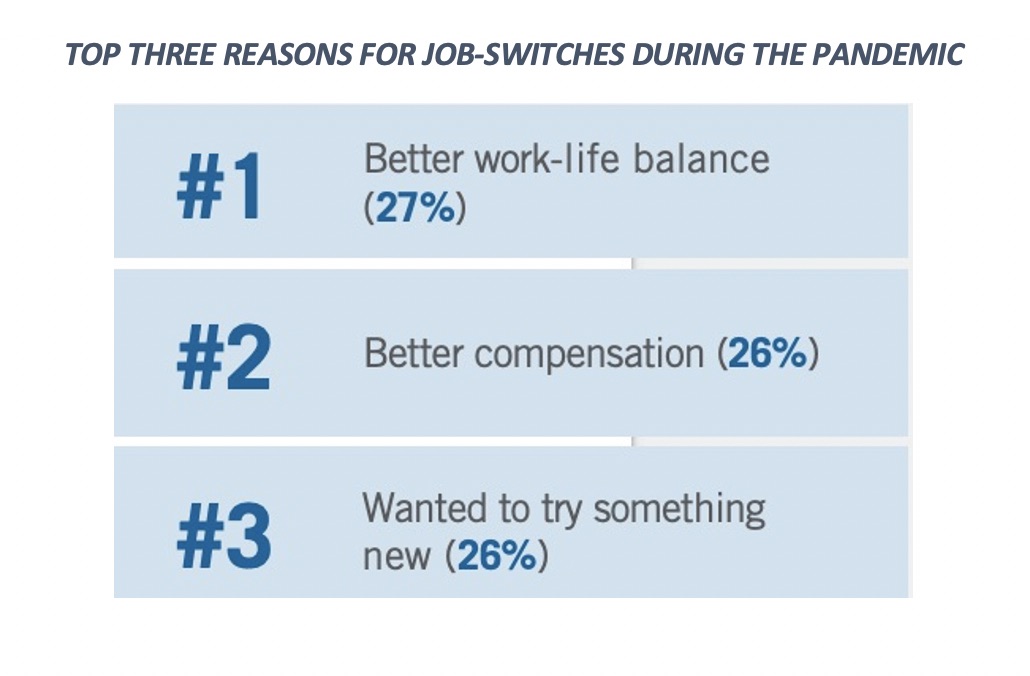As the future of work is reimagined, it’s a good time to reimagine your career...
Employers are ready to fill buildings again. Employees aren’t sure they’re ready to return—certainly not to “what was” in March 2020: defined workweeks and set work hours spent in communal, potentially far-away physical buildings. Long commutes. Many companies are promising “hybrid” work schedules—with few details about what “hybrid” actually means: as of mid-May, 68 percent of employers considering hybrid workforces had no detailed “return to work” plan in place.
Abandoning Ship to Chart a New Course: Employees' Mass Exodus
Numerous factors are driving what economists and labor analysts are calling “the great resignation,” but the recall of a fully in-person workforce has caused many, many individuals to reconsider their professional futures: of 649 workers polled by monster.com, 95 percent said they are considering switching jobs, with 92 percent indicating they’d also switch industries to take a position. 
This data tracks with information collected among working professionals in Kathleen Cashman-Walter’s signature Communications and Leadership Course—more than 100 of whom responded to a survey about workplace changes—a significant number have already changed jobs or careers (or both) during the pandemic.
“My time at home forced me to reflect on my life and re-evaluate what I want my future to look like,” said one student who switched both employers and careers. “I had to redefine the career path I wanted for myself and my family. It was the best change I could have made.”
Said another student, “I [am] finding the time to explore new career paths and change to what is true to me,” ambivalently adding, “[since] I have also experienced the range of flexibility from at-home work to needing to be in the office all the time.”
Getting What You Really Want...and Knowing What "That" Is
Amid the “Great Resignation,” Cashman-Walter and fellow MBS executive coach Abbe Rosenthal, MA, PCC, have been working overtime helping students reassess their careers and priorities—particularly what they envision as an ideal work-life balance.
“I’ve seen the question of ‘what do I want?’ become more difficult for students to answer over the past few years.” Says Cashman-Walter, an executive coach for more than 25 years and part of the MBS program since its inception. Now, “most students know for sure what they don’t want,” she says. And that’s pre-pandemic work culture, and a life where true work/life balance seems wholly unattainable.
In a recent report, “It’s Time for Leaders to Get Real About Hybrid," McKinsey & Company analysts conclude that the leaders who do reinvent and revamp their workforces will reap significant benefits.
Rosenthal—a DYL-certified executive coach who also cultivates and maintains employer partnerships—agrees. “I do a LOT of research by interviewing hiring leaders in human resources and talent acquisition,” she says.
“The majority of employees prefer either the all-remote or hybrid work model,” she continues. “Few want to be in the office five days per week.” Employers who remain inflexible can expect mass exits, she says. “Without the option of at least a hybrid work model, employers can expect a 17 percent increase in attrition—at least.”
"Promote Yourself Into Your Ideal Position"
In the meantime, Cashman-Walter and Rosenthal have been helping students prepare for a new work landscape and/or new jobs or careers by helping them identify their true "passion and purpose."
“What drives them?” asks Rosenthal. “Why are they unhappy in their current position, and—no holds barred—what does their ideal work/life balance look like? Based on their answers, we create detailed, actionable plans step by step.”
With the current job market, says Cashman-Walter, if you have clearly defined goals and in-demand skill sets, "you really can promote yourself into a future into which you create your ideal position."
As for all-remote workdays vs. 100 percent on-site work, it doesn’t have to be one or the other, says Cashman-Walter. “Our workforce of MBS students wants to have great impact,” she says. “They want to create, ideate, improve, and engage at many different levels—but under different circumstances than ‘what was.’” A hybrid workday could offer that solution for many she says.

In any event, “It’s a great time to reimagine what the labor market looks like,” say McKinsey & company analysts, with a new landscape that employees and employers can help drive.
For jobseekers, agree Rosenthal and Cashman-Walter, it’s a great time to reimagine your future.